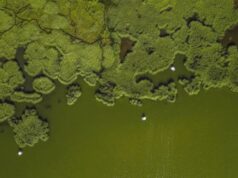Credit: From authors (Watson et al.)
Scientists have struggled for the past few decades to understand why air temperatures around Antarctica over the past one million years were almost perfectly in synch with atmospheric CO2concentrations. Both dipped down during glacial ice ages and back up again during warm interglacials.
By contrast, temperatures in the tropics and Northern Hemisphere were less closely tied to atmospheric CO2 concentrations.
“This relationship between Antarctica temperature and CO2 suggested that somehow the Southern Ocean was pivotal in controlling natural atmospheric CO2 concentrations,” said Dr Maxim Nikurashin from the ARC Centre of Excellence for Climate System Science.
“The key that unlocked the mystery was the colder atmosphere and extensive sea ice around Antarctica during the glacial period. Together they fundamentally changed top to bottom ocean circulation and enabled more CO2 to be drawn from the atmosphere.”
The researchers found that during glacial periods when the atmosphere was colder and sea ice was far more extensive, deep ocean waters came to the surface much further north of the Antarctic continent than they do today.
Find your dream job in the space industry. Check our Space Job Board »
This meant that the nutrients brought up from the bottom of the ocean spent more time on the surface of the ocean as the currents moved them southwards before the flow encountered Antarctica and circled back down to the bottom of the ocean.
Because the upwelled waters ran along the surface for a longer period of time, nutrients spent more time near the surface of the ocean where phytoplankton could feed on them for longer.
The biological processes that result from phytoplankton blooms directly take carbon out of the atmosphere. Some of this carbon then sinks to the bottom of the ocean when the phytoplankton die, locking it away in the deep sea for thousands of years.
“The biological processes that take up carbon from the atmosphere even take place in and under the ice — if that ice is not too thick — which is why the biological processes persisted for a lot longer during cooler periods,” the authors said.
“Our results suggest that this change in circulation and the consequent extended biological activity by itself took 30-60ppm of CO2 out of the atmosphere. That’s about one half of the glacial-interglacial change.”
However, when temperatures warm over the Antarctic regions, deep waters rise from the floor of the ocean much closer to the continent. This means nutrients are near the surface for a shorter time before returning to the deep ocean floor.
With less time on the surface there is less time for the biological processes to take place and less carbon is taken out of the atmosphere. This is the situation we see today.
“This finding is a major advance in understanding the natural carbon cycle, gained by applying a new understanding about how the “overturning circulation” of the Southern Ocean works,” said lead author Dr Andrew J Watson from the University of Exeter.
This article originally appeared at University of New South Wales.
Journal Reference:
Andrew J. Watson, Geoffrey K. Vallis, Maxim Nikurashin. Southern Ocean buoyancy forcing of ocean ventilation and glacial atmospheric CO2. Nature Geoscience, 2015; DOI: 10.1038/ngeo2538











